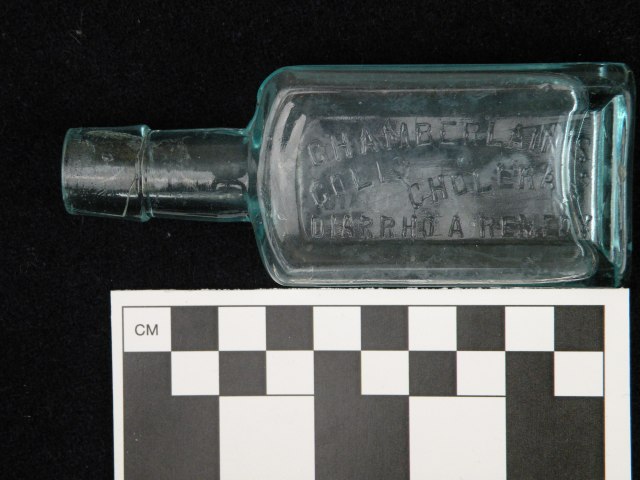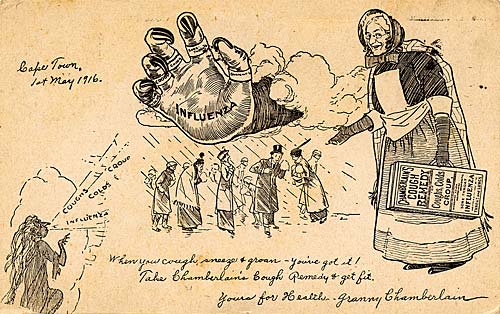Chamberlain’s Colic, Cholera and Diarrhea Remedy was one of many thousands of patent medicines that made incredible, and often false, claims about their effectiveness, and became tremendously profitable. Eventually government regulations were put in place to prevent medicine manufacturers from making unfounded claims about their products.

Bottle embossed “Chamberlain’s Colic, Cholera and Diarrhoea Remedy / Chamberlain Med Co. / Des Moines IA, USA
Excerpt from Balm of America: Patent Medicine Collection – History, Smithsonian National Museum of American History, Kenneth E. Behring Center
Patent medicines are named after the “letters patent” granted by the English crown. The first “letters patent” given to an inventor of a secret remedy was issued during the late 17th century. The patent granted the medicine maker a monopoly over his particular formula. The term “patent medicine” came to describe all pre-packaged medicines sold “over-the-counter” without a doctor’s prescription. In the United States very few preparations were ever actually patented.It did not take long for Americans to cultivate their own patent medicines. The numbers and types of medications grew steadily in the decades leading up to the Civil War. The patent medicine trade was very lucrative, encouraging many enterprising individuals to launch their own brands.The second half of the 19th century is considered to be the golden age of American patent medicines.Rapid increases in industry and manufacturing, urban living, advertising in national newspapers and magazines, and the absence of drug regulation all contributed to a boom in the production and consumption of patent medicines. Many people turned to patent medicines out of fear and distrust of contemporary medical practices. This was the period of “heroic medicine,” in which extreme techniques such as bloodletting and the use of harsh purgatives and emetics were often employed by physicians. Working before the advent of germ theory at the end of the 19th century, regular physicians had few therapies that could compete with the patent medicine industry’s promise of easy health in a bottle.Patent medicines were aggressively marketed. Manufacturers developed distinctive trademarks and packaging for their products and created memorable advertising campaigns. Unique and sometimes charming, many trademarks became instantly recognizable.Patent medicine makers were pioneers in the use of such advertising techniques as solicitation through the mail, the provision of free samples and promotional trinkets, national newspaper campaigns, outdoor signage, and testimonials. Popular patent medicine almanacs (free publications of 30 to 40 pages containing weather forecasts, horoscopes, and household and health advice) offered abundant advertising for the sponsoring companies’ products.Before the beginning of federal drug regulation in 1906, patent medicine manufacturers made any therapeutic claims for their products that they wished. In addition, patent medicines often contained dangerous levels of alcohol, opium, and other narcotics, potentially addictive and deadly ingredients that were not revealed to the consumer. Unscrupulous manufacturers greatly exaggerated the curative powers of their remedies, selling them as “panaceas” or “cure-alls.” The aptly named Swaim’s Panacea purportedly cured all “blood diseases” including scrofula, chronic rheumatism, ulcers, old sores, boils and carbuncles, diseases of the spine, catarrh, and wasting. A long and extravagant listing of conditions for which a medicine claimed to be beneficial, such as this list found on a box of Dr. Flint’s Quaker Bitters, was a hallmark of patent medicine packaging.Citizens groups, legislators, and journalists criticized the medicine industry for these practices. In 1905 and 1906 Collier’s magazine ran a series of influential articles by Samuel Hopkins Adams entitled “The Great American Fraud,” which exposed many of the deceitful and unsafe methods practiced by patent medicine manufacturers.Such exposes helped to promote the first federal Food and Drug Act, signed into law by President Theodore Roosevelt on June 30, 1906. The act was amended in 1912, and an even stronger Food, Drug and Cosmetic Act passed in 1938. These laws required drug labeling to include a list of ingredients and prohibited manufacturers from making false and misleading claims.From 1906 to 1918 manufacturers could label their products with a “guaranty” that their medicine complied with the new food and drug law. The 1906 law required manufacturers to label their products if any of the following ingredients were present: alcohol, morphine, opium, cocaine, heroin, eucaine, chloroform, cannabis indica, chloral hydrate, or acetanilide. A complete listing of all ingredients was not required until 1938.Federal food and drug regulation continues to evolve. Amendments to the laws in 1951 established clear distinctions between prescription and over-the-counter drugs. More recently, new regulations have introduced the category of “dietary supplements,” whose health claims must be labeled as “not evaluated by the Food and Drug Administration.” Also, a “Drug Facts” label has been required on all over-the-counter medicines since 2002.Despite dramatic changes in medical knowledge and federal regulation in the past 100 years, self-medication continues to be a popular form of treatment for many Americans. Although no longer referred to as “patent medicines,” over-the-counter products today offer an enormous array of choices without requiring the consultation of a physician. Manufacturers of these remedies continue to rely on extensive advertising to reach the consumer directly, employing many of the methods pioneered by patent medicine marketers over 100 years ago. |

Image from a 16-page pamphlet of short stories, c. 1910, published by the Chamberlain Medicine Co.
The pamphlet was only one of many advertising vehicles used by the patent medicine industry.
Excerpt from the post Cholera Medicine, in The Medicine Chest by Dr. Richard Cannon
“The word cholera is Latin for bilious disease, and has come to indicate a severe intestinal infection. In humans, certain strains of Vibrio cholera, a bacterium, produce the disease that can be severe and even fatal. Classic cholera is often referred to as Asiatic cholera because the disease was originally confined to Asia. Fluid and electrolyte replacement is the mainstay of treatment. Antibiotics shorten the duration of the disease. Opium and bismuth were used in 1886. A better vaccine has been developed, but safe food and water and prolonged breast-feeding are still the most important preventatives.European cholera is considered to be a less dangerous form of the disease. Cholera infantum refers to a severe diarrhea of young children, bacterial or viral, which is most common during the summer months. Winter cholera is milder and usually due to a virus. Chicken or fowl cholera is caused by Pasturella multocida, bacterium, and can be acute and often fatal or chronic. It responds to certain antibiotics.Hog cholera results from infection by a RNA virus of the genus Pestivirus. It has also been called swine fever. Vaccines help but allow the virus to continue in the body. Infected animals usually have to be slaughtered.Brothers Davis and Lowell Chamberlain established a proprietary medicine business in Marion, Iowa, in 1873. With their sister Izanna in 1881, they formed Chamberlain and Company in Des Moines. The firm became the Chamberlain Medicine Co. in 1892, and soon expanded to Australia, Canada and South Africa. They also put out a cough remedy, liniment, pain balm and hand lotion.” |
Excerpt from July 1906 issue of the Homeopathic Envoy
“Up in Vancouver “Chamberlain’s Colic, Cholera and Diarrhoea Remedy” was too much for a baby. The Vancouver World published the facts with the coroner’s verdict in the case. The Chamberlain people then sent a defense to the World with a large advertisement which was refused. The medicine company then sued the newspaper for libel. The newspaper is now demanding and will probably get such legislative enactment as will in future control the sale of such dangerous medicines…Ella Clark went to the Insane Asylum at Mt. Pleasant in January, 1906. She was a morphine fiend and used the Chamberlain Colic Cure in large quantities. In Shelburne Falls, Mass., there is a man who began to take the same remedy for diarrhoea and now takes from two to four ounces nightly for its sedative effect and his doctor says he is a nervous wreck.” |

A black and white cartoon on a postcard. The caption reads ‘Cape Town, 1st May 1916/ ‘When you cough, sneeze and groan – you’ve got it!/ Take Chamberlain’s Cough Remedy and get fit/ yours for Health, Granny Chamberlain’. Chamberlain’s Cough Remedy was made by the Chamberlain Medicine Company from 1908 to 1918.




Pingback: Quirky Des Moines #5 – A fortune built on foundation – TopTen DesMoines
Thank you for the inform. Re Chamberlin Medicine Co. I have a wood box hand made with the company name on the side of the box. I use it for storing my medications. It must be early 1900s . Laraine Crane larainecrane@gmail.com
Pingback: Snake oil was cheap, widely available and had some curative benefits. But what was actually in it? - Newspostalk - Global News Platform
Pingback: Snake oil was used as traditional medicine throughout history. How did it get such a bad name? – CBD News Insider